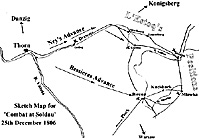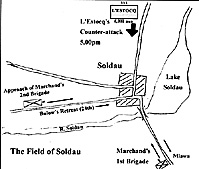The Combat at Soldau
25th December 1806
by Patrick E. Wilson, UK
| |
One of the difficulties of being a Napoleonic enthusiast come wargamer is the scale of the well known battles of the period. Which make it difficult not to say time consuming to re-enact one of them on the tabletop. However, if our preference is to re-fight historical encounters then the Napoleonic Wars does provide us with a whole variety of actions to enact on the tabletop. Here I speak of the smaller and lesser known actions of the major campaigns, actions that are entirely forgotten or ignored but which offer the enthusiast much scope to re-enact on the tabletop. For example, 1805 offers the actions of Haslach, Elchingen, Durrenstein and Hollabrünn. Whilst 1806 offers the actions of Schliez, Saalfeld, Halle, Altenzaum, Lubeck and Soldau. One could go on year by year, so that there are potentially no end of scenarios available to the enthusiast. One of these could be the "Combat de Soldau" fought between Marshal Ney's 6th Corps d'Armee and General L'Estocq's Prussian Corps on Christmas day 1806. December 1806 saw General Anton Wilhelm von L'Estocq's Prussian Corps defending the river Vistula above the important town of Thorn. He had destroyed the bridges at Thorn in response to a French advance in late November.
At present he had only a rearguard in the town to observe the movements of the French. Indeed, the main trust of the French Army seemed to be on Warsaw, about 120 miles south-east of L'Estocq's position. It was here that the Russian Army of General Levin Benningsen was assembling and where the main fighting of the campaign would take place. L'Estocq soon received orders to draw closer to the Russian positions, he had reached Strasbourg on the 6th December when he heard that his rearguard had been driven out of Thorn by French soldiers. Ordered to retake Thorn, L'Estocq attempted to do so two days later but by then it was too late, for Marshal Ney had established his forces there and was too strong for L'Estocq. Who was forced back upon Strasbourg, his rearguard being roughly handled by Ney's pursuing forces. On 13th December two corps advanced against L'Estocq's forces, Marshal Ney's along the Strasbourg road and Marshal Bessieres' cavalry on Biezun, Rypin and Soldau. Their task was to drive L'Estocq away from his Russian allies. By the 18th L'Estocq had retreated on Lautenburg, leaving Colonel von Bulow's light infantry to hold a defile at Gurzno. On the 19th Marshal Bessieres' advance guard under General Grouchy seized Biezun. This was a blow because it threatened L'Estocq's left and communications with the Russians, he immediately despatched a mixed brigade of two infantry and two cavalry regiments, and a horse battery through Soldau and Kuczbork to recapture Biezun. On the 23rd, the brigade reached Biezun but General Grouchy's 2nd Dragoon division totally defeated it in a series of charges and then drove it back upon Kuczbock with heavy losses, a French Dragoon regiment capturing a standard and three cannon. L'Estocq's now shattered brigade could only fall back on Soldau. Which was just as well for whilst the "Combat de Biezun" had raged Ney had fell on Bulow's rearguard at Gurzno and drove it back upon Soldau also. By the 24th December Bulow had joined up with the remnants of L'Estocq's mixed brigade at Soldau. Soldau in 1806 was a strong position, according to F. Loraine Petre, it was covered by a stream, a canal and a lake on its left. The forty-sixth bulletin of the French Army speaks of Soldau as a place "defended by morasses and other obstacles." It was also a place that was important for L'Estocq's communications with the Russian right and therefore it was a place that L'Estocq would have to fight for, but first he needed to concentrate his forces as they were scattered from Lautenburg to Mlawa. This explains the lateness of L'Estocq's attack to recapture Soldau on the afternoon of the 25th December 1806. On the morning of the 25th December Soldau was defended by perhaps no more than a battalion and 8 or 10 cannon. Presumably the shattered remnants of L'Estocq's mixed brigade had retired and left Colonel Bulow's Fusilier battalion and a battery to defend the town. On the French side Marshal Ney had directed his 1st Division under General Jean Gabriel Marchand against Soldau and Mlawa, supporting him on the left with his 2nd Division under General Gaspard Amedee Gardanne, which was at Gurzno. His corps cavalry presumably in close support of these formations. General Marchand, an experienced officer, led his 2nd brigade to storm Soldau. This brigade, General Roguet's 69th and 76th regiments, made short work of Bulow's Fusiliers and despite some stiff street fighting were masters of Soldau by 2.00pm. L'Estocq however, having ascertained the direction of Ney's attack, assembled his forces to retake Soldau but it was not until 5.00pm that he could do so because of the scattered nature of his command. By which time Marchand's 1st brigade had arrived to support the 2nd and Marchand had had adequate enough time to put Soldau into a state of defence.
L'Estocq made his attack at 5.00pm from the Neidenburg road on the northern gate of Soldau. Led by three hundred volunteers, L'Estocq's 6,000 men, despite the fury of their attack and the valour with which they fought, could not get beyond the outer edge of the town and after some vicious hand-to-hand fighting in which the majority of the three hundred volunteers were killed, L'Estocq was forced to withdraw. But the fight continued into the night as L'Estocq rallied and attacked again and again. In all, perhaps four separate attacks were made but little progress could be made against Roguet's gallant regiments, the 69th and 76th Ligne, which covered themselves in glory on this day. Disheartened, L'Estocq eventually retreated on Neidenburg and found himself completely severed from the Russian right, as Ney's forces occupied Lautenburg and Soldau whilst Bessieres occupied Mlawa and Bogarzin. However, the weather and cautious nature of the commanding Marshal in that area, Bernadotte, allowed L'Estocq time to rally and regroup, whilst news of Russian successes at Pultusk and Golymin helped restore his men's moral. Though L'Estocq was still required to retreat further to maintain his alignment with his Russian allies, much to his annoyance, as it meant abandoning more Prussian territory. Such is the historical background to the "Combat de Soldau." The subject is interesting because it has a number of possibilities, from re-fighting the whole series of encounters to just the single action of Soldau. It also allows the wargamer to compare the opposing sides at a manageable tactical level, the Prussian mixed brigade or Grouchy's dragoon division at Biezun or Marchand's 1St Division and L'Estocq's Prussian division at Soldau. The opportunities are wide and worthwhile, and no doubt will result in a better understanding of Napoleonic formations as a whole at that period in time. The forces needed for the scenario are as follows: L'Estocq's Prussianscan be represented by a single division of the period. 2nd East Prussian Fusilier Brigade
Battalion Schachtmeier Battalion Bulow Prittwitz Hussars 10 Sqdns 1 x 6pdr horse battery. Line Troops:1st brigade:
Schoening Infantry Regiment 2 Battalions Grenadier battalion Schlieffen 1 x 12pdr foot battery. 2nd brigade:
Diericke Infantry Regiment 2 Battalions Grenadier battalion Fabecky 1 x 12pdr foot battery. Attached cavalry:
Esebeck Dragoon regiment 5 Sqdns Wagenfeld Ciurassiers 5 sqdns 1 x 6pdr horse battery. Note: each Line/Grenadier battalion had a battalion gun giving an additional 5 guns to each brigade. Marshal Ney's 6th Corps d'Armee1st Division:MGen. J.G.Marchand Brigade Villatte
39th Ligne 2 battalions Brigade Roguet
76th Ligne 2 battalions 1 x 81b foot battery (8 guns). 2nd Division:Gen. G.A.Gardanne Brigade Marcognet
27th Ligne 2 battalions Brigade Delabassee
59th Ligne 2 battalions 1 x 8pdr battery (8 guns). Corps cavalry:Genl. A. Colbert de Chabanais.
10th Chasseurs a cheval 4 Sqdns 1 x 4pdr horse battery (6 guns) Corps reserve artillery:
Bessieres Advance Guard2nd Dragoon Division: General Emmanuel de Grouchy.
4th Dragoon Regiment 3 Sqdns 10th Dragoon Regiment 3 Sqdns 11th Dragoon Regiment 3 Sqdns 13th Dragoon Regiment 3 Sqdns 22nd Dragoon Regiment 3 Sqdns 1 x 4pdr horse battery (3 guns). Sources and further reading.Chandler, David G., The Campaigns of Napoleon (New York: Macmillian, 1966. Reprint London: Weidenfeld and Nicolson, 1987).
Inspired by Soldau: The Battle of Durnstein 1805 (FE42) Back to Table of Contents -- First Empire #37 Back to First Empire List of Issues Back to MagWeb Master Magazine List © Copyright 1997 by First Empire. This article appears in MagWeb (Magazine Web) on the Internet World Wide Web. Other military history articles and gaming articles are available at http://www.magweb.com |

